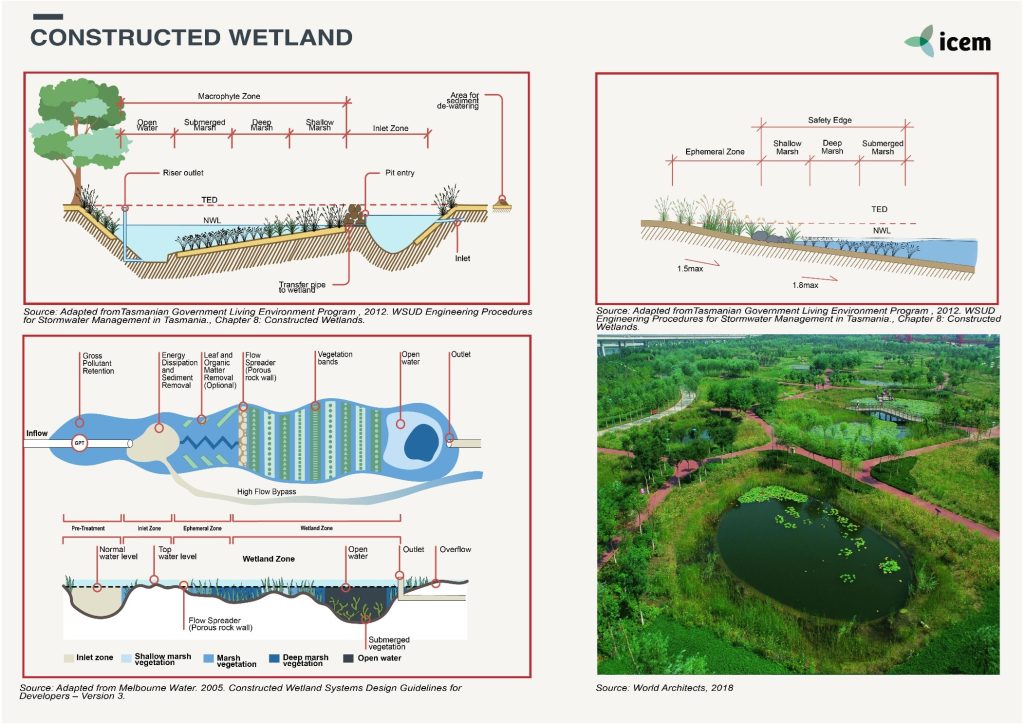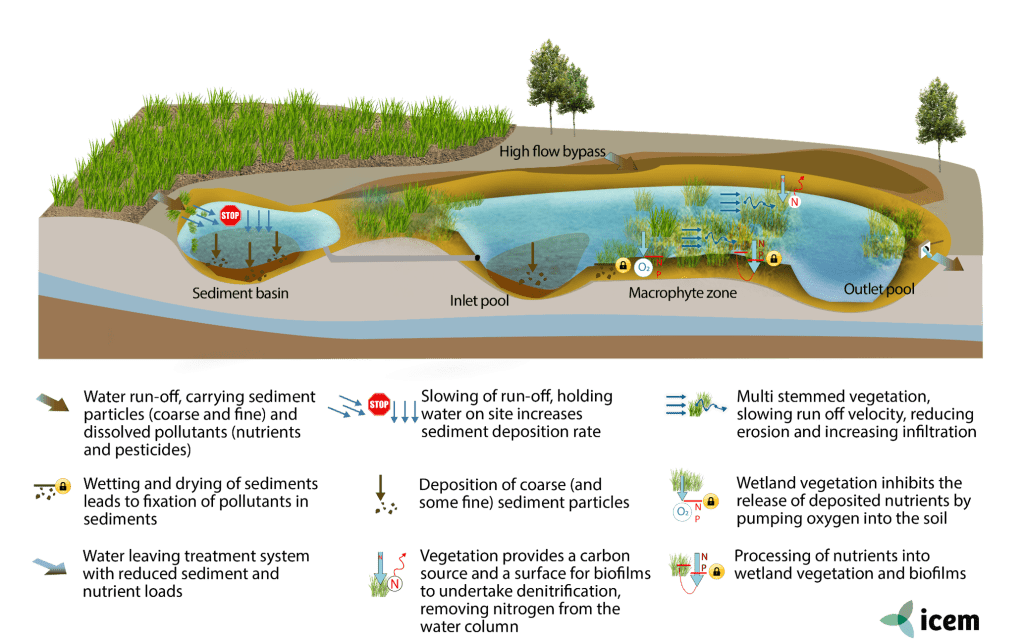| Suburban | River | High-cost | Fluvial flooding | |
| DESCRIPTION | ||||||||||||||||
| Measures
|
Wetlands are densely vegetated water bodies specifically designed to accept and treat stormwater by using a series of natural processes which include sedimentation, fine filtration, adhesion and biological uptake and transformation processes to remove pollutants. They range from large schemes covering many hectares down to ‘micro’ wetlands filling a small available pocket of land and can be designed with a natural look or be more engineered with hard edges. Water levels in the wetland rise during a rainfall event and are detained and then slowly released over two to three days allowing the treatment processes, particularly the uptake of soluble pollutants to be optimized. Wetlands can be located within a drainage path but should feature a bypass system to divert stormwater around the wetland to protect the integrity of the system. Water depth varies throughout the wetland to allow for a variety of vegetation and pollutant removal processes and they are frequently protected upstream by a sediment basin.
Constructed wetlands can be used to: ● Reduce pollutant loads to meet water-quality targets; ● Meet partial or full storage requirements for local stormwater detention standards; ● Retrofit existing developed areas. Three basic design variations of the constructed wetland concept are discussed in this section: ● Wetland basin; ● Multicell wetland or pond/wetland combination; ● Subsurface gravel wetlands. |
|||||||||||||||
| Location | Wetlands are not well suited to sites with:
● Undulating and steep topography (>5%): sites with large cross falls need higher embankments which increases cost; ● Limited space: if there is less than 100 m2 available, the confined scale of the wetland will prevent the flow from being uniformly distributed in the wetland because of edge effects. ● Shallow bedrock, high water tables and sandy soils all lead to construction difficulties; ● High water levels: vegetation can be difficult to establish and maintain if water levels are too deep; ● Large flow volumes and velocities. Sites with any of the above characteristics are likely to require additional design considerations with potential cost implications. The loss or lack of emergent wetland vegetation is a key risk to the overall treatment function and resilience of the wetland. Some potential causes of this include: ● The normal water level is too deep for healthy plant growth; ● Damage to plants from waterfowl; ● Prolonged inundation during rainfall events, due to the wetland being wrongly sized. If access to the wetland is provided, consideration must be given to pedestrian and traffic safety by using suitable barriers and fencing. Wetlands attract wildlife so their location close to roads and railways is undesirable. |
|||||||||||||||
| Design options and Performance | The design of constructed wetlands for managing urban surface runoff requires a multi-disciplinary approach. Due to the inherent fluctuations in surface water discharge and pollution loadings which are typical of stormwater runoff no two wetlands share the same design aspects so it is difficult to set performance criteria since retention time and hydraulic loading are difficult to define. As a result design rules for wetlands have been developed from empirical performance data and techniques such as drainage/area ratio for example.
Stormwater wetland design levels: descriptions and performance.
|
|||||||||||||||
| Feasibility criteria
|
Contributing drainage area (CDA): The CDA must be large enough to sustain a permanent water level within the stormwater wetland. If the only source of wetland hydrology is stormwater runoff, then several dozen acres of the drainage area are needed to maintain constant water elevations. Smaller drainage areas are acceptable if the bottom of the wetland intercepts the groundwater and intercepts the groundwater table or if the designer or approving agency is willing to accept periodic wetland drawdowns. Stormwater wetlands typically have a drainage area of 5-10 hectares.
Space requirements: Stormwater wetlands normally require a footprint that takes up about 3% of the contributing drainage area, depending on the average depth of the wetland and the extent of its deep pool features. Steep slopes: A design alternative to the stormwater wetland in steep terrain is the regenerative stormwater conveyance (RSC) system. The regenerative stormwater conveyance can be used to bring stormwater down to steeper grades through a series of step pools. This can serve to bring stormwater down to outfalls where steep drops can create design challenges. Alternatively, stormwater wetlands on steep sites can be split into various cells with adequate conveyance between cells to take advantage of flatter spots on the site. Available hydraulic head: The depth of a stormwater wetland is usually constrained by the hydraulic head available on the site. The bottom elevation is fixed by the elevation of the existing downstream conveyance system to which the wetland will ultimately discharge. Because stormwater wetlands are typically shallow, the amount of head needed (usually a minimum of 0.6-12 meters) is typically less than for wet ponds. Minimum setbacks: Local ordinances and design criteria should be consulted to determine minimum setbacks to property lines, structures, utilities, and wells. As a general rule, the edges of stormwater wetlands should be located at least 3 meters away from property lines, 7.6 meters from building foundations, 15.2 meters from septic system fields, and 30.5 meters from drinking water wells. Community and environmental concerns: Stormwater wetland designs should strive to address the following: · Aesthetics and habitat: Stormwater wetlands can create wildlife habitats and can also become an attractive community feature. Designers should think carefully about how the wetland plant community will evolve over time · Existing forests: Given the large footprint of a stormwater wetland, there is a strong chance that the construction process may result in extensive tree clearing. The designer should preserve mature trees and may consider creating a wooded wetland; · Mosquito risk: mosquito control can be a concern for stormwater wetlands if they are undersized or have a small CDA; · Deepwater zones serve to keep mosquito populations in check by providing habitat for fish and other pond life that prey on mosquito larvae. Simple precautions can be taken to minimize mosquito breeding habitat within stormwater wetlands. For example, constant inflows, benches that create a habitat for natural predators, and constant pool elevations. Design geometry for stormwater wetlands: Research and experience have shown that the internal design geometry and depth zones are critical in maintaining the pollutant removal capability and plant diversity of stormwater wetlands. Wetland performance is enhanced when the wetland has multiple cells, longer flow paths, and a high ratio of surface area to volume. Whenever possible, stormwater wetlands should be irregularly shaped with long, sinuous flow paths. The following design elements are required for stormwater wetlands: Multiple-cell wetlands (level 2 designs): When a level 2 design is selected, the wetland should be divided into at least four internal subcells of different elevations: the forebay, at least two wetland cells, and a micro pool outlet. The first cell (the forebay) is deeper and is used to receive runoff from the pond cell or the inflow from a pipe or open channel and distribute it evenly into successive wetland cells. The purpose of the wetland cells is to create an alternating sequence of aerobic and anaerobic conditions to maximize nitrogen removal. The fourth wetland cell is located at the discharge point and serves as a micro pool with an outlet structure. Each wetland subcell can be differentiated by sand berms (anchored by a rock at each end), back-filled coir fiber logs, or forested peninsulas extending as wedges across 95% of the wetland cell width. Micro-topographic features: While the slope profile within individual wetland cells should generally be flat from inlet to outlet, stormwater wetlands must have internal structures that create variable micro-topography. This is defined as a mix of above-pool vegetation. Designers will need to incorporate at least two of the following internal design features to meet the microtopography requirements for level 2 designs: · Tree peninsulas, high marsh wedges or rock filter cells configured perpendicular to the flow path; · Tree islands above the normal pool elevation and maximum detention zone formed by coir fiber logs; · Inverted root wads or large woody debris. Detention storage ponding: Where a level 1 design is adopted the detention elevation above the permanent pool should be 0. 3m or less. Where a level 2 design is adopted the detention storage limits are as follows: ● Multicell wetlands must be designed so that the water-level fluctuation associated with the maximum “design volume” storm is limited to 15-20 cm; ● The maximum water-level fluctuation during the larger design storm associated with local detention requirements should be limited to 30 cm in the wetland cells. Pool depths; Level 1 wetland design may have a mean pool depth greater than 0.3 meters. Level 2 wetland cells must have a mean pool depth of less than or equal to 0.3 m. Deep pools: Approximately 25 % of the wetland design volume must be provided in at least three deeper pools – located at the inlet (forebay), center and outlet of the wetland. Approximately 60% of this deep pool volume should be allocated to the forebays. Each deep pool should have a depth of 50-120 cm. Slide slope: Side slopes for the wetland should generally have gradients of 5H:1V. Such mild slopes promote better establishment and growth of vegetation. They also contribute to easier maintenance and a more appearance. Technical design: Wetlands can be designed with hard edges and be part of a streetscape or forecourt or they can be designed to be more natural looking. The design will typically consider the following factors; local hydrology, topography and geology, catchment drainage characteristics, land availability and cost, size and type of the receiving water body and water quality classification and objective. Wetlands will normally have the following elements: ● A sedimentation zone to treat coarser sediments before discharge to the vegetated wetland zone. This zone will typically incorporate a high flow bypass system to avoid damage to vegetated areas and resuspension of trapped sediments in storm events larger than the wetland design storm; ● A vegetated wetland zone (known as the macrophyte zone) with aquatic plants to provide biological treatment, decomposition and transformation of stormwater pollutants and plant litter. There should be an inlet pool to enable even flow distribution through the vegetated areas, intermediate pools between areas of dense plantings to mitigate short-circuiting of flows, and an outlet pool to minimize the risk of blockage of the outlet; ● Pipework to ensure open water zones have a consistent water level and to enable the wetland to be drawn down for maintenance; ● An outlet system that acts as a hydraulic control to ensure the wetland operates as per the designed hydrological regime. Wetlands are generally sized to be 7 to 10% of the catchment area. Within the total area the size of the components is typically; ● Macrophyte zone should cover 80% of the wetland area and be of variable depth to accommodate a range of plant species with different planting depths; ● Inlet and outlet ponds are typically 10% of the macrophyte zone; ● Sediment basin is typically around 5% of the macrophyte zone area; ● High flow bypass is typically sized to convey the 1% Annual Exceedance Probability (AEP) event. Soil media: n/a Soil slope: Should not be constructed on sites with slope > 4% Surface cover: Macrophyte plants Materials: construction equipment including trucks and excavators, concrete elements, as per design, for inlet, containment and outlet structures and pipework. |
|||||||||||||||
| Operation and maintenance | Following an initial establishment period when close supervision is required, the ongoing maintenance of wetlands should be limited provided adequate protection measures have been put in place upstream of the wetland and appropriate vegetation species have been selected. | |||||||||||||||
| Cost and benefits | Medium to high-cost measure. Wetlands provide flood control by detaining the runoff for 2 to 3 days whilst treatment processes occur. They provide full treatment of stormwater by removing fine sediments, metals and particulates and dissolved nutrients and by retaining water in the landscape, providing local microclimate benefits and enhancing evapotranspiration. Larger wetlands can provide recreational opportunities such as walking paths and resting areas and may provide a habitat for wildlife and fish. | |||||||||||||||
| Design solution | Wetlands are designed primarily to remove stormwater pollutants associated with fine to colloidal particulates and dissolved contaminants. The key operational design criteria for constructed wetlands are:
● Promote sedimentation of particles larger than 125 µm within the inlet zone ● Discharge water from the inlet zone into the macrophyte zone for removal of fine particulates and dissolved contaminants through the processes of enhanced sedimentation, filtration, adhesion and biological uptake ● Ensure that the required detention period is achieved for all flow through the wetland system through the incorporation of a riser outlet system ● Ensure adequate flood protection of the macrophyte zone from scouring during the above-design conditions by designing for bypass operation when inundation in the macrophyte zone reaches the design maximum extended detention depth. However, some wetlands have not fulfilled their design expectations so care must be taken to find solutions to the following design issues: accumulation of litter; accumulation of oil and scum at ‘dead zones’; infestation of weeds or invasive species; mosquito problems; algal blooms; and scouring of sediment and banks, especially during high flows. These problems should be minimized or avoided by applying appropriate engineering design principles. |
|||||||||||||||
| Environmental performance | Well-designed and maintained permanent water bodies can offer important aesthetic, amenity and wildlife benefits to development sites. Wetlands can be designed as natural features with shallow, grassed side slopes or they can be hard-landscaped features that complement the character of dense urban environments. Well-managed wetlands can add significant economic value to development, increasing property values and attracting business and tourism. Public acceptability of wetlands strongly depends on their aesthetic quality, their effective integration within the landscape and their performance as a community resource. It is therefore important that landscape architects should be part of the design team, particularly regarding their form, layout and planting arrangement. | |||||||||||||||
| Sources | ● Chadwick, A. J. and J. Morfett. 1986. Hydraulics in Civil and Environmental Engineering.
● CIRIA. 2015. The SuDS Manual. ● Environment Agency. 2003. Guidance Manual for Constructed Wetlands, R&D Technical Report P2-159/TR2. ● Melbourne Water. 2008. Constructed Wetland Systems, Design Guidelines for Developers, Version 3. ● Melbourne Water. 2005. WSUD Engineering Procedures: Stormwater, Chapter 9 – Wetlands. ● UN Human Settlements Program. 2008. Constructed Wetlands Manual. |
|||||||||||||||
Originally developed under the ADB ‘TA-9417 VIE: Secondary Green Cities Development Project – Output 2: Demonstrated sustainable and resilient development in Hue, Ha Giang and Vinh Yen’. Adapted for the UN-CTCN project ‘Climate risk assessment for subnational adaptation and establishment of a local climate information system for climate change adaptation (LISA) in Cambodia’.




